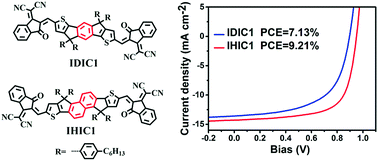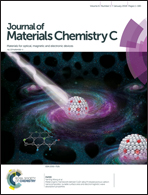Enhancing the performance of a fused-ring electron acceptor via extending benzene to naphthalene†
Abstract
We compared an indacenodithiophene(IDT)-based fused-ring electron acceptor IDIC1 with its counterpart IHIC1 in which the central benzene unit is replaced by a naphthalene unit, and investigated the effects of the benzene/naphthalene core on the optical and electronic properties as well as on the performance of organic solar cells (OSCs). Compared with benzene-cored IDIC1, naphthalene-cored IHIC1 shows a larger π-conjugation with stronger intermolecular π–π stacking. Relative to benzene-cored IDIC1, naphthalene-cored IHIC1 shows a higher lowest unoccupied molecular orbital energy level (IHIC1: −3.75 eV, IDIC1: −3.81 eV) and a higher electron mobility (IHIC1: 3.0 × 10−4 cm2 V−1 s−1, IDIC1: 1.5 × 10−4 cm2 V−1 s−1). When paired with the polymer donor FTAZ that has matched energy levels and a complementary absorption spectrum, IHIC1-based OSCs show higher values of open-circuit voltage, short-circuit current density, fill factor and power conversion efficiency relative to those of the IDIC1-based control devices. These results demonstrate that extending benzene in IDT to naphthalene is a promising approach to upshift energy levels, enhance electron mobility, and finally achieve higher efficiency in nonfullerene acceptor-based OSCs.



 Please wait while we load your content...
Please wait while we load your content...